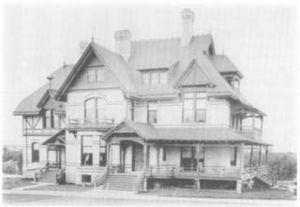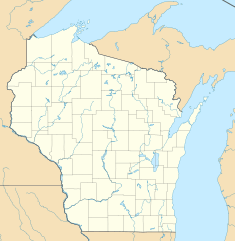Vulcan Street Plant facts for kids
Quick facts for kids Vulcan Street Plant |
|
|---|---|
|
Location of Vulcan Street Plant in Wisconsin
|
|
| Official name | Vulcan Street Plant |
| Location | Appleton, Outagamie County, Wisconsin, United States |
| Coordinates | 44°15′12″N 88°24′42″W / 44.25333°N 88.41167°W |
| Dam and spillways | |
| Impounds | Fox River |
| Power station | |
| Commission date | September 30, 1882 |
| Turbines | 1 |
| Installed capacity | 12.5 kW |
The Vulcan Street Plant was a very important place in history. It was the very first power plant built by Thomas Edison that used water power (hydroelectric) to make electricity. This plant was located on the Fox River in Appleton, Wisconsin. It started working on September 30, 1882.
Experts agree that the Vulcan Street Plant was the first hydroelectric power station in North America. It provided electricity to homes and businesses. Because it was so important, it is now recognized as a National Historic Mechanical Engineering Landmark and an IEEE milestone.
The original Vulcan Street Plant was inside the Appleton Paper and Pulp Company building. Sadly, this building burned down in 1891. Later, a copy of the plant was built on South Oneida Street.
Contents
How the Plant Started
The idea for the Vulcan Street Plant came from H. J. Rogers. He was the president of two companies in Appleton: the Appleton Paper and Pulp Co. and the Appleton Gas Light Co. He thought of the idea for a hydroelectric power station while on a fishing trip with his friend, H. E. Jacobs.
The Appleton Edison Electric Light Company
H. E. Jacobs worked for the Western Edison Light Company in Chicago. He told H. J. Rogers about Thomas Edison's plan to build a power plant in New York City. This plant, called the Pearl Street Plant, would use steam to make electricity.
Rogers learned about Edison's new electric lights and generators. He then gathered a group of investors. They wanted to create one of the first hydroelectric power stations in the world. Because of this, the Appleton Edison Electric Light Company was created on May 25, 1882.
Edison's Pearl Street Plant was still being built. Meanwhile, the founders of the Appleton Edison Electric Light Company started planning the Vulcan Street Plant. These founders were H. E. Jacobs, A. L. Smith, H. D. Smith, and Charles Beveridge.
In July 1882, an engineer named P. D. Johnston visited Appleton. He worked for the Western Edison Light Company. He explained how Edison's lighting system worked to the Appleton founders. After this meeting, they decided to test water-powered electricity. They would install it in their homes and factories first.
They ordered two Edison "K" type generators. The first generator was put in H. J. Roger's paper mill. This was the Appleton Paper and Pulp Company. It started working on September 30, 1882. The second generator was placed in its own building on Vulcan Street. It began operating on November 25, 1882.
Early Problems and Big Successes
The first generator started on September 27, 1882, but it did not work well. So, the person who installed it, Edward T. Ames, came back to Appleton. He worked to fix the problem.
After a few days of trying different things, the generator was fixed. It successfully started on September 30, 1882. This was only 26 days after Thomas Edison's steam-powered Pearl Street Plant began working in New York. That plant started on September 4, 1882. The first generator at Vulcan Street made about 12.5 kilowatts of power.
The first places to get light from the Vulcan Street Plant were H.J. Rogers' home, the Appleton Paper and Pulp Company building, and the Vulcan Paper Mill. These places were directly connected to the generator.
At first, there were many problems because the generator was directly connected to the waterwheel. The water from the Fox River did not flow at a steady speed. This meant the lights did not stay a constant brightness. They often burned out.
This problem was solved by moving the generator to a small building next to the main one. There, it was connected to a separate water wheel. This allowed the power to be spread out more evenly.
Back then, there were no voltage regulators. Operators had to look at the lights to see if they were bright enough. They would then adjust the voltage based on what they saw. Also, there were no electricity meters. Customers paid a set monthly fee based on how many electric lamps they had. Because of this, many people left their lights on all night!
The first electric wires in Appleton were made of bare copper. This caused challenges because many things were made of wood. The wiring inside buildings had a thin layer of cotton for insulation. It was attached to walls using wood pieces. Fuse boxes, light sockets, and switch handles were also made of wood.
Appleton's First Electrically Lit Buildings

H. J. Rogers' home is now the Hearthstone Historic House Museum. It is one of the few places left that still shows how wiring and lighting looked when electricity first became common. The original Vulcan Street Plant and the Appleton Paper and Pulp Company building burned down in 1891. The Vulcan Paper Mill was taken apart in 1908.
After the Vulcan Street Plant was destroyed by fire, an exact copy was built. It is on South Oneida Street and opened on September 30, 1932. This replica was carefully built to look just like the original plant.
This site was recognized as an ASME National Historic Engineering Landmark on September 15, 1977.


